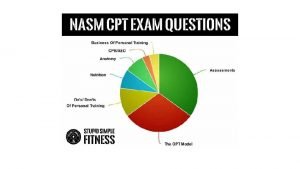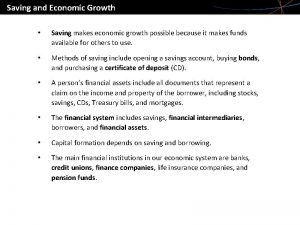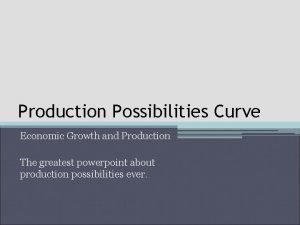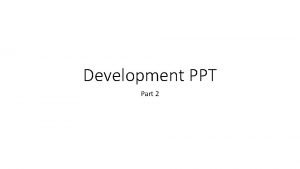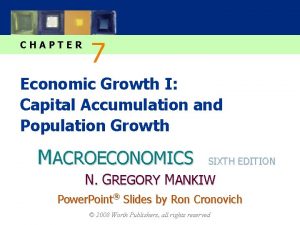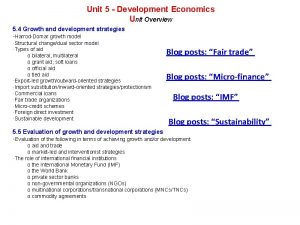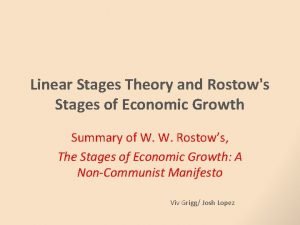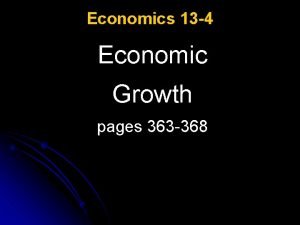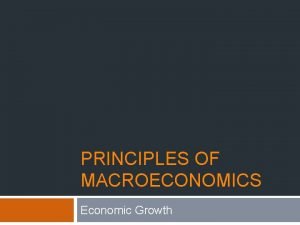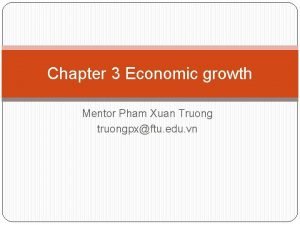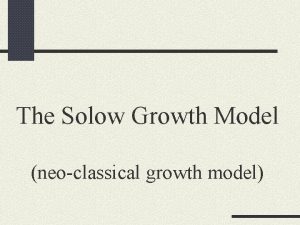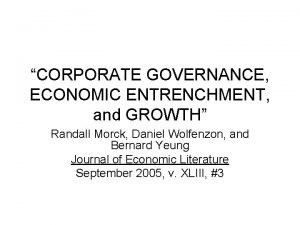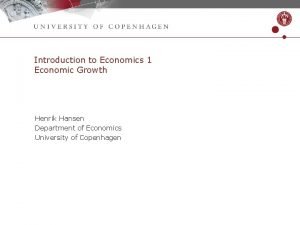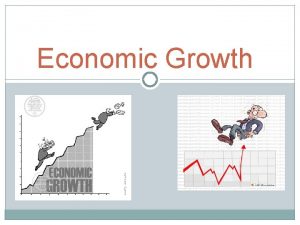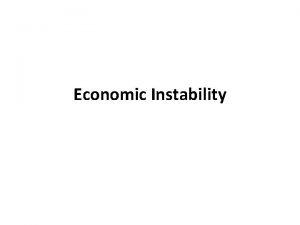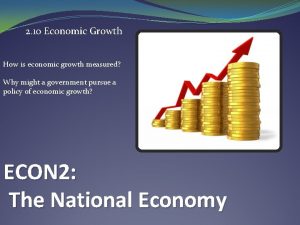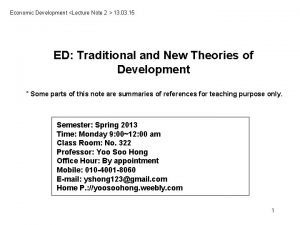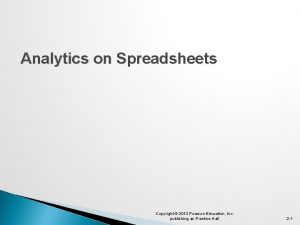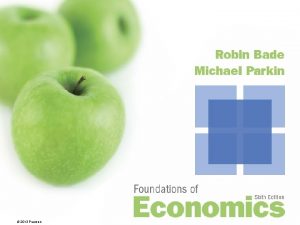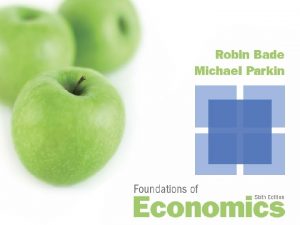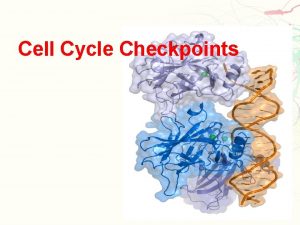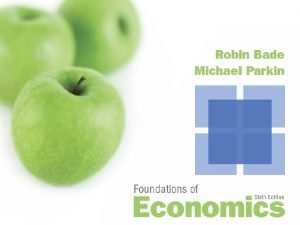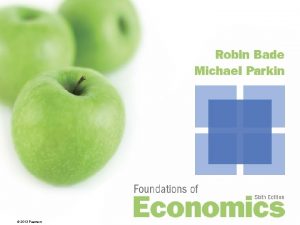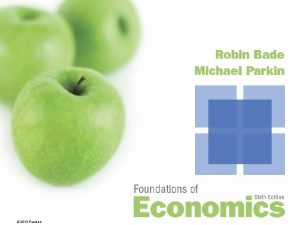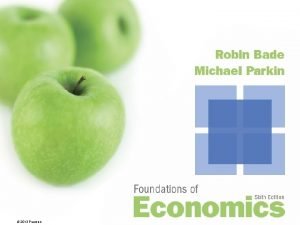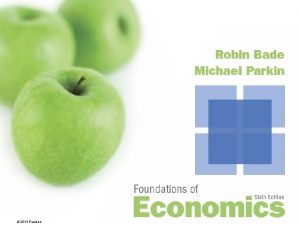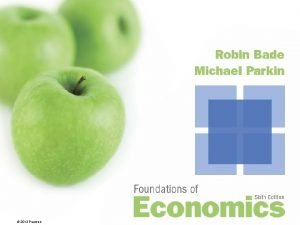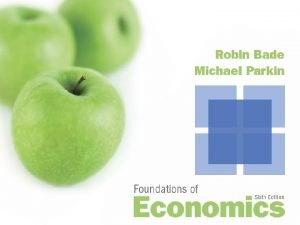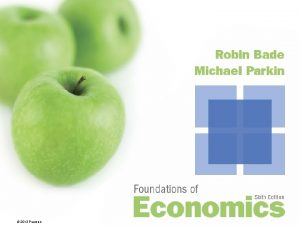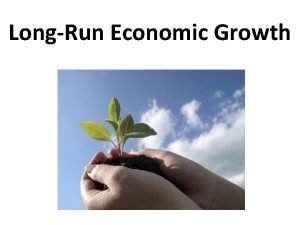2013 Pearson Economic Growth 25 CHECKPOINTS 2013 Pearson









































- Slides: 41

© 2013 Pearson

Economic Growth 25 CHECKPOINTS © 2013 Pearson

Click on the button to go to the problem Checkpoint 25. 1 Checkpoint 25. 3 Problem 1 Problem 2 Problem 3 In the news Clicker version Checkpoint 25. 4 Problem 1 Clicker version Problem 2 Clicker version Problem 3 Clicker version In the news Problem 4 Checkpoint 25. 2 Problem 5 Problem 1 Problem 2 In the news © 2013 Pearson In the news Clicker version

CHECKPOINT 25. 1 Practice Problem 1 Mexico’s real GDP was 8, 762 billion pesos in 2010 and 9, 105 billion pesos in 2011. Mexico’s population growth rate in 2011 was 1 percent. Calculate Mexico’s economic growth rate in 2011 and the growth rate of real GDP person in Mexico in 2011. © 2013 Pearson

CHECKPOINT 25. 1 Solution The economic growth rate equals the percentage change in real GDP: [(Real GDP in 2011 – Real GDP in 2010) ÷ Real GDP in 2010] x 100. When we substitute the numbers, Mexico’s economic growth rate equals [(9, 105 billion – 8, 762 billion) ÷ 8, 762] x 100. Mexico’s economic growth rate in 2011 was 3. 9 percent. © 2013 Pearson

CHECKPOINT 25. 1 Growth rate of real GDP person equals the growth rate of real GDP minus the population growth rate. When we substitute the numbers, Growth rate of real GDP person = (3. 9 – 1) percent, which is 2. 9 percent. The growth rate of real GDP person in Mexico in 2011 was 2. 9 percent. © 2013 Pearson

CHECKPOINT 25. 1 Practice Problem 2 Calculate the approximate number of years it will take for real GDP person to double if an economy maintains an economic growth rate of 12 percent a year and a population growth rate of 2 percent a year. © 2013 Pearson

CHECKPOINT 25. 1 Solution The growth rate of real GDP person equals the economic growth rate minus the population growth rate. Real GDP person grows at (12 – 2) percent a year, which is 10 percent a year. The Rule of 70 tells us that the level of a variable that grows at 10 percent a year will double in 70 ÷ 10 years, or 7 years, if the growth rates are maintained. It will take 7 years for real GDP person to double. © 2013 Pearson

CHECKPOINT 25. 1 Practice Problem 3 Calculate the change in the number of years it will take for real GDP person in India to double if real GDP person increases from 8 percent a year to 10 percent a year. © 2013 Pearson

CHECKPOINT 25. 1 Solution The Rule of 70 tells us that a variable that grows at 8 percent a year will double in 70 ÷ 8 years, which is approximately 9 years. By increasing its growth rate to 10 percent a year, the variable will double in 7 years. Real GDP person in India will two years earlier. © 2013 Pearson

CHECKPOINT 25. 1 In the news ADB reduces China’s growth estimate Since 1980, China’s real GDP person has grown at 10 percent per year. The Asian Development Bank (ADB) cut its estimate for China’s growth to 9. 3 percent this year. Source: Bloomberg, September 13, 2011 If China’s growth rate remains at 9. 3 percent a year, how many additional years will it take for China to double its real GDP person? © 2013 Pearson

CHECKPOINT 25. 1 Solution With a growth rate of 10 percent a year, real GDP person will double in 7 years (70 ÷ 10), If the growth rate is maintained at 9. 3 percent a year, real GDP person will double in 7. 5 years (70 ÷ 9. 3). It will take an additional 0. 5 years for real GDP person to double. © 2013 Pearson

CHECKPOINT 25. 2 Practice Problem 1 The table provides some data for an economy in 2009 and 2010. Calculate the growth rate of real GDP in 2010. © 2013 Pearson

CHECKPOINT 25. 2 Solution Growth rate of real GDP in 2010 equals (Real GDP in 2010 – Real GDP in 2009) ÷ Real GDP in 2009 x 100 = ($1, 050 – $1, 000) ÷ $1, 000) x 100 = 5 percent. © 2013 Pearson

CHECKPOINT 25. 2 Practice Problem 2 The table provides some data for an economy in 2009 and 2010. Calculate the labor productivity in 2009 and 2010. Calculate the growth rate of labor productivity in 2010. © 2013 Pearson

CHECKPOINT 25. 2 Solution Labor productivity equals real GDP per hour of labor. In 2009, labor productivity = $1, 000 ÷ 25 = $40. 00 an hour. In 2010, labor productivity = $1, 050 ÷ 25. 6 = $41. 02 an hour. Labor productivity growth rate = (41. 02 – 40. 00) ÷ 40. 00 x 100 = 2. 55 percent. © 2013 Pearson

CHECKPOINT 25. 2 In the news Labor productivity on the rise The BLS reported the following data for the year to June 2011: In the nonfarm sector, output increased by 2. 4 percent as aggregate hours increased 1. 6 percent; in the manufacturing sector, output increased 4. 6 percent as aggregate hours increased by 2. 1 percent. Source: bls. gov/news. release As aggregate hours increased, output increased, but did labor productivity in each sector increase? In which sector was growth in labor productivity greater? © 2013 Pearson

CHECKPOINT 25. 2 Solution Output = Aggregate hours × Labor productivity. In each sector, output increased by more than the increase in aggregate hours, so labor productivity must have increased. Output growth in the manufacturing sector was almost double that in the nonfarm sector while growth of aggregate hours was approximately the same, so labor productivity must have increased by a larger percentage in manufacturing than in the nonfarm sector. © 2013 Pearson

CHECKPOINT 25. 3 Practice Problem 1 What is the classical growth theory and why does it say that economic growth will eventually end? © 2013 Pearson

CHECKPOINT 25. 3 Solution The classical growth theory predicts that labor productivity growth is temporary: When labor productivity increases, real GDP person increases and because it exceeds the real income needed to maintain life, a population explosion occurs. The population becomes so large that capital per worker and labor productivity decrease and real GDP person returns to its subsistence level. © 2013 Pearson

CHECKPOINT 25. 3 Practice Problem 2 What is the driving force of economic growth according to new growth theory? Why does it predict that the economic growth will never end? © 2013 Pearson

CHECKPOINT 25. 3 Solution The driving force of economic growth according to new growth theory is a persistent incentive to innovate and an absence of diminishing returns. New growth theory predicts that economic growth will never end because our unlimited wants will lead us to make choices that will bring ever-greater productivity and perpetual economic growth. © 2013 Pearson

CHECKPOINT 25. 3 Study Plan Problem What is the driving force of economic growth according to new growth theory? A. B. C. D. Advancements in medical research. The pursuit of leisure. Religion Productive activities that can be replicated with no diminishing returns. E. Foreign investment. © 2013 Pearson

CHECKPOINT 25. 3 In the news The productivity watch Former Federal Reserve chairman Alan Greenspan attributes the growth of labor productivity to IT investments that boosted labor productivity, which boosted company profits, which led to more IT investments, and so on, leading to a nirvana of high growth. Source: Fortune Magazine, September 4, 2006 Which of the growth theories that you’ve studied in this chapter best corresponds to the explanation given by Mr. Greenspan? © 2013 Pearson

CHECKPOINT 25. 3 Solution Mr. Greenspan is describing the new growth theory. According to this theory, the endless pursuit of profit leads to innovations (IT innovations in the period described here) that increase labor productivity, shift the production function upward, increase the demand for labor, raise the real wage rate, and increase profit. The perpetual pursuit of profit will bring persistent economic growth. © 2013 Pearson

CHECKPOINT 25. 4 Practice Problem 1 What are the preconditions for economic growth? © 2013 Pearson

CHECKPOINT 25. 4 Solution The preconditions for economic growth are economic freedom, private property rights, and markets. Without these preconditions, people have little incentive to undertake the actions that lead to economic growth. © 2013 Pearson

CHECKPOINT 25. 4 Study Plan Problem What are the preconditions for economic growth? A. B. C. D. E. Entrepreneurial spirit and low unemployment. A large standing army and small government. A small government and property rights. Low unemployment and a large standing army. Economic freedom, private property rights, and markets. © 2013 Pearson

CHECKPOINT 25. 4 Practice Problem 2 Why does much of Africa experience slow economic growth? © 2013 Pearson

CHECKPOINT 25. 4 Solution Some African countries experience slow economic growth because they lack economic freedom, private property rights are not enforced, and markets do not function well. People in these countries have little incentive to specialize and trade or to accumulate both physical and human capital. © 2013 Pearson

CHECKPOINT 25. 4 Study Plan Problem Why does much of Africa experience slow economic growth? A. B. C. D. It lacks motivation to grow. It lacks aid from developed countries. It lacks natural resources and labor. It lacks economic freedom, private property rights that are enforced, and markets that function well. E. It lacks UN assistance. © 2013 Pearson

CHECKPOINT 25. 4 Practice Problem 3 Why is economic freedom crucial for achieving economic growth? © 2013 Pearson

CHECKPOINT 25. 4 Solution Economic freedom is crucial for achieving economic growth because economic freedom allows people to make choices and gives them the incentives to pursue growth-producing activities. © 2013 Pearson

CHECKPOINT 25. 4 Study Plan Problem Why is economic freedom crucial for economic growth? A. It gives the incentive to save, invest, expand human capital, and discover and apply new technologies. B. It protects workers’ rights and prevents unfair firing. C. It upholds democracy, which is essential if an economy is to grow. D. Only good government can make the right investment decisions. E. It ensures that the majority of citizens make the most important decisions. © 2013 Pearson

CHECKPOINT 25. 4 Practice Problem 4 What role do property rights play in encouraging economic growth? © 2013 Pearson

CHECKPOINT 25. 4 Solution Clearly defined property rights and a legal system to enforce them give people the incentives to work, save, invest, and accumulate human capital. © 2013 Pearson

CHECKPOINT 25. 4 Study Plan Problem What role do property rights play in encouraging economic growth? A. They increase the penalty for theft. B. The give governments the power to acquire property in the public interest. C. They create more equality of income. D. They strengthen the incentive to work, save, invest, and accumulate human capital. E. They ensure that debts are always paid. © 2013 Pearson

CHECKPOINT 25. 4 Practice Problem 5 Explain why, other things remaining the same, a country with a well-educated population has a faster economic growth rate than a country that has a poorly educated population. © 2013 Pearson

CHECKPOINT 25. 4 Solution A well-educated population has more skills and a greater labor productivity than a poorly educated population. A well-educated population can contribute to the research and development that create new technology. © 2013 Pearson

CHECKPOINT 25. 4 Practice Problem 6 India’s economy hits the wall Just six months ago, the Indian economy was growing rapidly; now growth has halted. India needs to spend $500 billion upgrading its infrastructure and education and health-care facilities. Agriculture remains unproductive; and reforms, like strengthening the legal system, have been ignored. Source: Business. Week, July 1, 2008 Explain how the measures reported in the news clip could lead to faster economic growth in India. © 2013 Pearson

CHECKPOINT 25. 4 Solution Investment in infrastructure and education and heath-care facilities would increase India’s stock of physical capital, which would increase labor productivity. Better education and heath care would increase human capital and again increase labor productivity. With better technology and more capital used on farms, productivity of farm workers would increase. Strengthening the legal system could better enforce property rights. These measure could lead to faster growth in labor productivity and faster growth in real GDP person. © 2013 Pearson
 Economic growth vs economic development
Economic growth vs economic development Growth and development conclusion
Growth and development conclusion Udl checkpoints
Udl checkpoints Dialogue control in session layer
Dialogue control in session layer Static postural assessment
Static postural assessment Dynamic postural assessment: pulling
Dynamic postural assessment: pulling Homochromatin
Homochromatin Checkpoints in the cell cycle
Checkpoints in the cell cycle Organic vs inorganic growth
Organic vs inorganic growth Neoclassical growth theory vs. endogenous growth theory
Neoclassical growth theory vs. endogenous growth theory Primary growth and secondary growth in plants
Primary growth and secondary growth in plants Relative growth rate equation
Relative growth rate equation Chapter 35 plant structure growth and development
Chapter 35 plant structure growth and development Monocot vs eudicot
Monocot vs eudicot Geometric exponential growth
Geometric exponential growth Growthchain
Growthchain Saving makes economic growth possible because
Saving makes economic growth possible because Factors of economic growth
Factors of economic growth Ppc curve economic growth
Ppc curve economic growth Rostow's model
Rostow's model Solow model of economic growth
Solow model of economic growth Harrod domar model economics
Harrod domar model economics What are the 5 stages of rostow's model
What are the 5 stages of rostow's model Why is economic growth important
Why is economic growth important Economic growth is defined as
Economic growth is defined as Long run economic growth
Long run economic growth Economic growth trends
Economic growth trends Solow's model of economic growth
Solow's model of economic growth Solow's model of economic growth
Solow's model of economic growth Corporate governance and economic growth
Corporate governance and economic growth Brazil's quest for economic growth
Brazil's quest for economic growth Economic growth and development
Economic growth and development Long run economic growth graph
Long run economic growth graph Chapter 13 economic instability
Chapter 13 economic instability Short run economic growth graph
Short run economic growth graph Ssema
Ssema Economic growth is defined as
Economic growth is defined as Economic growth occurs when
Economic growth occurs when Five stages of economic growth
Five stages of economic growth Economics unit 1 lesson 2 difficult choices
Economics unit 1 lesson 2 difficult choices 2013 pearson education inc
2013 pearson education inc 2013 pearson education inc
2013 pearson education inc




